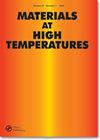Introduction to MIMA-2 conference special issue
IF 0.9
4区 材料科学
Q4 MATERIALS SCIENCE, MULTIDISCIPLINARY
引用次数: 0
Abstract
In addition, four additional presentations were made in a final Plenary Session (Session 6). Following a Rapporteur overview summary of the MIMA-2 conference proceedings, the MHT MIMA-2 Special Issue contains 7 papers based on presentations made during the course of this conference. Importantly, papers originating from four of the main sessions are included [an eighth paper based on a third session presentation was published in Materials at High Temperatures, 2023, 40(1), 88-98]. For example, the first session, which was concerned with High Temperature Materials Issues, mainly (but not exclusively) covered developments associated with 9Cr-3W3Co-VNbBN (alternatively referred to as MARBN). The MARBN steel was originally developed in Japan by a group headed by Fujio Abe, who has continued to be active in studying the metallurgy of this alloy, and a number of other associated advanced martensitic steels. It was therefore appropriate that the first presentation in the first session of the conference was by Dr Abe, and that the 9Cr-3W-3CoVNbBN alloy played an integral part in the first paper in this Special Issue. In fact, Dr Abe’s paper is more generally concerned with The role of inclusions on the degradation in creep life and rupture ductility of ferritic power plant steels and, more specifically, considers the role of BN, AlN and MnS particles on degradation of the creep properties of 9 to 12%Cr martensitic steels and a 1%Cr bainitic steel at temperatures in the range 550 to 700°C. A second paper from the first session concerns Experience of P93 manifold welding under fabrication conditions, and was by de-Smet, Tang & Bok (of Siemens Energy Heat Transfer Technology). While MARBN is an ASME Code Case variant of P93 (or 9Cr-3W-3Co), the presented evidence indicates that further optimisation of the heat treatment and welding procedures are required in order to attain the required impact toughness properties for weldments of the more generic grade of this steel. The second session was concerned with Plant Life Assessment, with the contribution of Professor Nonaka (of Tohoku University) from the Plenary Session representing the Japanese perspective on this topic. Entitled Activities to advance residual life evaluation techniques for highly aged power plant, Professor Nonaka’s paper concerns the wide ranging activities of a Japanese Materials Sciences Society Working Group and recent developments in techniques being adopted for the life assessment of very old power generation units. Two papers based on presentations from the third session (Plant Inspection and Maintenance) are included. The first by Pascal Decoussemaeker (of GE Power, Switzerland) is concerned with Risk-based life management for steam turbines and generators, and considers the necessary important details of an asset management program to ensure reliable operation over the commercial life of, in particular, steam power plant. The third session presentation of Adam Wojcik (Matelect, UK) et al formed the basis of A review of the factors affecting the use of electrical potential drop (EPD) for creep life monitoring. Direct current (DC) and alternating current (AC) variants of electrical potential drop instrumentation have been widely used for identifying and monitoring sub-critical crack growth in the laboratory and in plant in a variety of engineering materials for over 50 years. The novelty of the work described in the Wojcik et al paper is the successful development of a unit combining both DC and AC EPD instrumentation to give advance warning of the evolution of creep damage in power plant components. The research represented the outcome of work conducted as part of an ETD-led industry-sponsored project.MIMA-2会议特刊简介
此外,在最后一次全体会议(第6届会议)上还作了四次报告。在对MIMA-2会议记录进行报告员概述总结之后,MHT MIMA-2特刊包含了7篇基于本次会议期间所作报告的论文。重要的是,来自四个主要会议的论文被包括在内[基于第三次会议演讲的第八篇论文发表在高温材料,2023,40(1),88-98]。例如,第一届会议关注的是高温材料问题,主要(但不完全)涵盖了与9Cr-3W3Co-VNbBN(也称为MARBN)相关的发展。MARBN钢最初是由日本的一个由Abe Fujio领导的小组开发的,他一直积极研究这种合金的冶金,以及其他一些相关的先进马氏体钢。因此,由Abe博士在会议第一届会议上的第一次介绍是适当的,9Cr-3W-3CoVNbBN合金在本期特刊的第一篇论文中发挥了不可或缺的作用。事实上,Abe博士的论文更广泛地关注了夹杂物在铁素体电厂钢蠕变寿命和断裂延展性退化中的作用,更具体地说,考虑了BN、AlN和MnS颗粒在550至700°C温度范围内对9至12%Cr马氏体钢和1%Cr贝氏体钢蠕变性能退化的作用。第一届会议的第二篇论文是关于在制造条件下P93管汇焊接的经验,由de-Smet, Tang和Bok(西门子能源传热技术)撰写。虽然MARBN是P93(或9Cr-3W-3Co)的ASME规范案例变体,但现有证据表明,为了获得更通用等级的这种钢的焊接所需的冲击韧性,需要进一步优化热处理和焊接工艺。第二届会议的主题是植物生命评估,全体会议上野中教授(日本东北大学)的发言代表了日本对这一主题的看法。野中教授的论文题为“推进高老化电厂剩余寿命评估技术的活动”,涉及日本材料科学学会工作组的广泛活动以及用于非常老的发电机组寿命评估的技术的最新发展。本文收录了第三届会议(设备检查和维护)的两篇论文。第一个是Pascal Decoussemaeker(来自瑞士通用电气电力公司),他关注的是汽轮机和发电机基于风险的寿命管理,并考虑了资产管理计划的必要重要细节,以确保在商业寿命期间(特别是蒸汽发电厂)的可靠运行。Adam Wojcik (Matelect, UK)等人在第三次会议上介绍了影响使用电位降(EPD)进行蠕变寿命监测的因素。50多年来,直流(DC)和交流(AC)型电势降仪器已广泛用于实验室和工厂中各种工程材料的亚临界裂纹扩展识别和监测。Wojcik等人的论文中所描述的工作的新颖之处在于,他们成功地开发了一种结合直流和交流EPD仪器的装置,可以提前预警电厂部件蠕变损伤的演变。该研究是etd主导的行业赞助项目的一部分。
本文章由计算机程序翻译,如有差异,请以英文原文为准。
求助全文
约1分钟内获得全文
求助全文
来源期刊

Materials at High Temperatures
工程技术-材料科学:综合
CiteScore
1.90
自引率
15.40%
发文量
58
审稿时长
>12 weeks
期刊介绍:
Materials at High Temperatures welcomes contributions relating to high temperature applications in the energy generation, aerospace, chemical and process industries. The effects of high temperatures and extreme environments on the corrosion and oxidation, fatigue, creep, strength and wear of metallic alloys, ceramics, intermetallics, and refractory and composite materials relative to these industries are covered.
Papers on the modelling of behaviour and life prediction are also welcome, provided these are validated by experimental data and explicitly linked to actual or potential applications. Contributions addressing the needs of designers and engineers (e.g. standards and codes of practice) relative to the areas of interest of this journal also fall within the scope. The term ''high temperatures'' refers to the subsequent temperatures of application and not, for example, to those of processing itself.
Materials at High Temperatures publishes regular thematic issues on topics of current interest. Proposals for issues are welcomed; please contact one of the Editors with details.
 求助内容:
求助内容: 应助结果提醒方式:
应助结果提醒方式:


